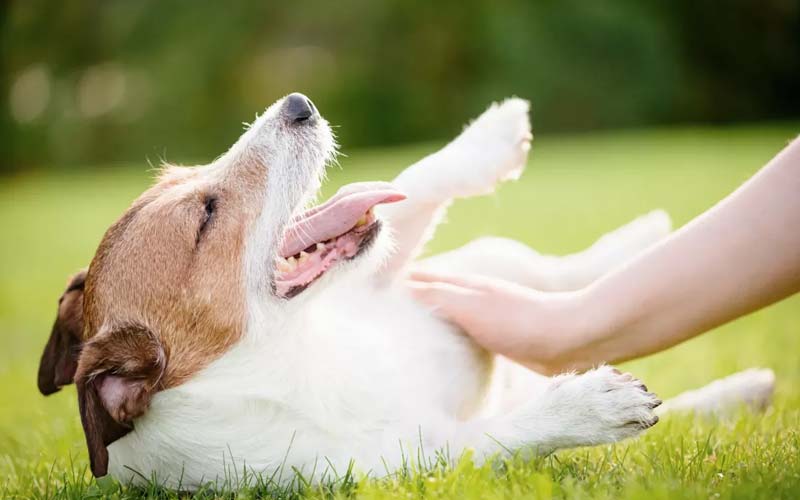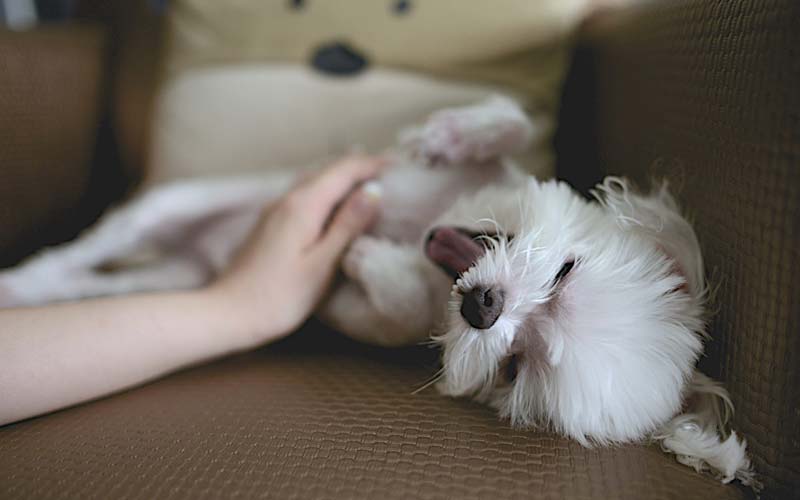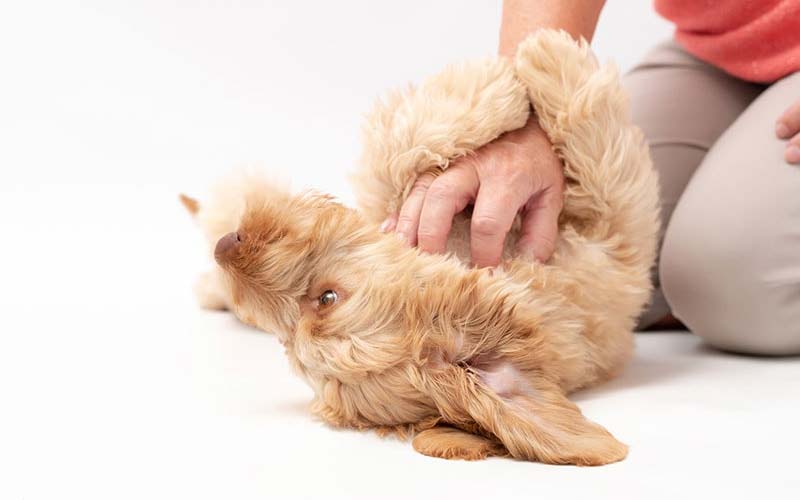If you’ve ever given your dog a belly rub and noticed their leg kicking in response, you’re not alone. This quirky and endearing behavior is something most dog owners have experienced. But have you ever wondered why it happens? Is it a sign of pure joy, a playful reaction, or something entirely different?

The answer lies in a fascinating biological mechanism known as the scratch reflex, a natural, involuntary response triggered by nerve stimulation. While it may seem like your dog is happily dancing along to your touch, this reflex is rooted in their evolutionary biology. Understanding why your dog reacts this way isn’t just interesting; it can help you better interpret their comfort levels and strengthen your bond with your furry friend.
In this article, we’ll explore the science behind this leg-kicking phenomenon, discuss whether dogs actually enjoy belly rubs, and offer tips to ensure your interactions with your dog are both fun and respectful. Whether you’re a lifelong dog owner or just curious about canine behavior, this insight will help you connect with your pet on a deeper level.
1. What Happens When You Rub Your Dog’s Belly?
When you rub your dog’s belly, their leg might start kicking seemingly out of nowhere. This reaction, often accompanied by an amusing thumping sound, is known as the scratch reflex. It’s an involuntary response triggered by the stimulation of nerves beneath their skin. While it might resemble the human reaction to being tickled, it’s actually rooted in a very different mechanism—one designed to protect dogs from irritants like fleas or ticks.
The scratch reflex occurs because the sensory nerves in your dog’s skin send signals to their spinal cord when stimulated. The spinal cord then automatically activates the muscles in the leg, resulting in that familiar kicking motion. This bypasses the brain entirely, meaning your dog isn’t consciously deciding to move their leg—it’s a reflexive action.
Interestingly, not all dogs respond to belly rubs with the same intensity. Some may kick energetically, while others barely move at all. This variation depends on factors such as the dog’s sensitivity, personality, and even the specific area being touched. For example, some dogs may only respond when certain “trigger spots” are rubbed.
While the kicking might seem like a playful reaction, it’s important to remember it’s not a deliberate behavior. Understanding this can help you interpret your dog’s actions more accurately and ensure that your affection aligns with their comfort level.

2. The Science Behind the Scratch Reflex
The scratch reflex is a fascinating biological response deeply embedded in your dog’s nervous system. When you tickle or rub certain areas of your dog’s belly, sensory nerves under their skin detect the touch. These nerves, specialized for picking up tactile stimuli, send signals to the spinal cord almost instantly.
What’s interesting is that this process bypasses the brain entirely. Instead of involving conscious thought, the spinal cord acts as a control center for this reflex. Upon receiving the signal, it sends a message to the leg muscles, causing the rapid kicking motion you see. This automatic reaction is why your dog’s leg kicks without them intending to move it—it’s an involuntary reflex.
From an evolutionary standpoint, this reflex plays a critical role in a dog’s survival. In the wild, irritants like fleas, ticks, or other pests can latch onto a dog’s skin, causing discomfort and potential health risks. The scratch reflex evolved to help dogs quickly respond to such stimuli, enabling them to shake off or dislodge these pests without needing to consciously process the sensation.
To better understand this, think about the knee-jerk reflex humans experience at the doctor’s office. When a doctor taps your knee, it triggers an automatic response where your leg kicks forward. You don’t decide to kick—it just happens. Similarly, when you rub your dog’s belly and hit a sensitive spot, their leg kicks as part of this deeply ingrained survival mechanism.
Understanding the science behind the scratch reflex not only demystifies this amusing behavior but also highlights its importance in a dog’s biological toolkit. While it might seem like a playful response to your affection, it’s actually a sophisticated system designed to protect your dog from harm.

3. Do Dogs Enjoy Belly Rubs?
When a dog rolls over and exposes its belly, it’s often interpreted as an invitation for affection. In many cases, this posture does indicate trust and submission, as the belly is one of the most vulnerable areas of a dog’s body. By showing it, your dog is signaling that they feel safe with you. However, this doesn’t automatically mean they want a belly rub—or that they’ll enjoy it.
The leg-kicking response triggered by belly rubs is an involuntary action, a result of the scratch reflex. While it might look like your dog is having fun, the kicking doesn’t necessarily indicate pleasure. For some dogs, the sensation of having their belly rubbed can be overstimulating or even mildly irritating, depending on their preferences and sensitivity.
To determine whether your dog genuinely enjoys belly rubs, pay close attention to their body language:
- Signs of comfort: Look for a relaxed body posture, a wagging tail, soft and happy facial expressions, or a dog that leans into your touch. These cues indicate your dog is enjoying the interaction.
- Signs of discomfort: Watch for stiffening, turning their head away, lip licking, growling, or attempts to move away. These are clear signals that your dog may not be comfortable with the interaction.
To respect your dog’s boundaries while showing affection, start by gauging their reaction to gentle pats or strokes. If your dog seems to enjoy it, you can proceed with a belly rub. If they show signs of discomfort, stop immediately and try another way to show affection, like scratching behind their ears or gently petting their back.
Ultimately, every dog is different, and their preferences can vary. By learning to read your dog’s cues and respecting their boundaries, you can ensure your interactions are both enjoyable and strengthening for your bond. Belly rubs can be a delightful way to connect—but only if your dog is genuinely on board.

4. Common Myths and Misconceptions
Belly rubs and the accompanying leg-kicking behavior are often misunderstood, leading to several myths about what they mean. Let’s address some of the most common misconceptions to help you better understand your dog’s behavior.
Myth 1: Kicking Always Means the Dog Loves It
One of the most widespread beliefs is that when a dog’s leg kicks during a belly rub, it’s a sign of enjoyment. In reality, this response is purely reflexive and doesn’t necessarily indicate any emotion. The kicking happens because the scratch reflex is triggered, not because your dog is consciously expressing happiness or pleasure. While some dogs might enjoy the belly rub itself, the kicking is an automatic action unrelated to their feelings.
Myth 2: All Dogs Like Belly Rubs
It’s easy to assume that all dogs love belly rubs, especially when some seem to seek them out. However, this isn’t universally true. For some dogs, a belly rub can feel overstimulating or even uncomfortable, particularly if they’re sensitive in that area. Other dogs might roll over to show submission or trust but aren’t actually inviting physical interaction.
Why Understanding the Reflex Matters
Recognizing that the scratch reflex is involuntary and distinct from emotional responses can help prevent overhandling your dog. If a dog shows signs of discomfort, continuing to rub their belly can lead to stress or frustration. Understanding these nuances allows you to respect your dog’s preferences and focus on interactions that they genuinely enjoy. By avoiding assumptions based on myths, you can ensure your dog feels secure and loved in every interaction.

5. How to Use This Knowledge to Bond With Your Dog
Understanding the science behind your dog’s leg-kicking response and their comfort with belly rubs can greatly enhance your relationship and interactions. By paying attention to their body language and respecting their boundaries, you can ensure that your affection is well-received and helps build trust.
1. Pay Attention to Body Language
The best way to gauge whether your dog enjoys an interaction is by observing their body language. Signs of comfort include a relaxed body, a wagging tail, soft eyes, and a calm demeanor. If your dog seems tense, turns away, or displays other signs of discomfort, it’s important to stop and reassess the situation. By tuning in to these cues, you can tailor your interactions to keep them enjoyable for your dog.
2. Find Other Ways to Show Affection
Not all dogs love belly rubs, and that’s perfectly okay. If your dog isn’t a fan, try offering affection in other ways. Many dogs enjoy ear rubs, gentle pats on the back, or scratching behind their ears. You might also try bonding through activities like playing fetch, going for walks, or simply spending quiet time together. The key is to find what makes your dog feel safe and happy.
3. Make Interactions Enjoyable and Stress-Free
Remember, your dog’s comfort is the priority. Avoid overstimulating them, and be mindful of their unique preferences. Whether they love belly rubs or not, the goal is to create positive, low-stress experiences that foster a deeper connection. By respecting your dog’s boundaries and preferences, you can strengthen your bond while keeping interactions stress-free and enjoyable.

Conclusion
In conclusion, the leg-kicking response when you tickle your dog’s belly is a fascinating reflex, not necessarily a sign of enjoyment. Triggered by the scratch reflex, this behavior is an involuntary, automatic reaction designed to help dogs protect themselves from irritants like fleas or ticks. While some dogs may love belly rubs, others may not, and it’s important to understand that the reflex doesn’t always indicate emotional pleasure.
By paying close attention to your dog’s body language, you can better gauge their comfort level and ensure that your interactions are both enjoyable and respectful. Remember, not all dogs enjoy belly rubs, and finding alternative ways to show affection, such as ear rubs or gentle pats, can strengthen your bond without overstimulating your pet.
Ultimately, understanding the science behind your dog’s behavior and respecting their preferences helps create a positive, trusting relationship. The next time your dog’s leg kicks in response to a belly rub, you’ll know it’s just a reflex—and you’ll be better equipped to respond to their needs and comfort level.
So, take the time to observe your dog’s cues and adjust your approach accordingly. By respecting their boundaries and showing affection in ways they enjoy, you can create an even stronger bond with your loyal companion.